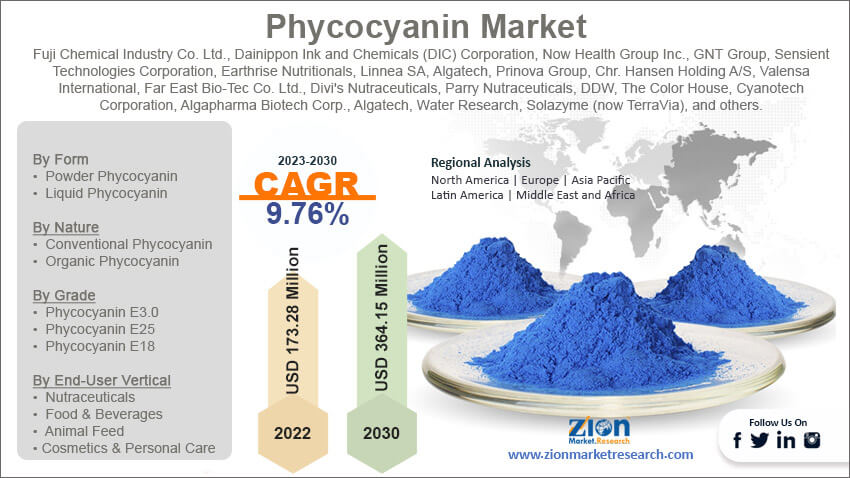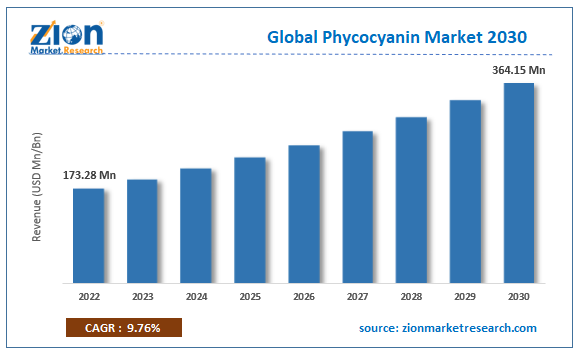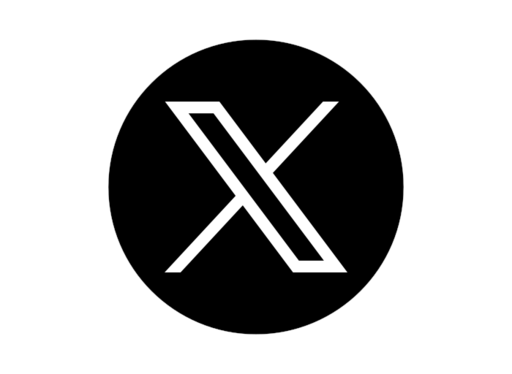Phycocyanin Market Size Report, Industry Share, Analysis, Growth, Forecasts, 2023-2030

Phycocyanin Market By Form (Powder Phycocyanin and Liquid Phycocyanin), By Nature (Conventional Phycocyanin and Organic Phycocyanin), By Grade (Phycocyanin E3.0, Phycocyanin E25, and Phycocyanin E18), By End-User Vertical (Nutraceuticals, Food & Beverages, Animal Feed, Cosmetics & Personal Care, and Others), and By Region - Global and Regional Industry Overview, Market Intelligence, Comprehensive Analysis, Historical Data, and Forecasts 2023 - 2030
| Market Size in 2022 | Market Forecast in 2030 | CAGR (in %) | Base Year |
|---|---|---|---|
| USD 173.28 Million | USD 364.15 Million | 9.76% | 2022 |
Phycocyanin Industry Prospective:
The global phycocyanin market size was worth around USD 173.28 million in 2022 and is predicted to grow to around USD 364.15 million by 2030 with a compound annual growth rate (CAGR) of roughly 9.76% between 2023 and 2030.
Phycocyanin Market: Overview
Phycocyanin is a pigment-protein complex. It has a characteristic light blue color and belongs to the light-harvesting phycobiliprotein family. These are water-soluble proteins found in certain algae such as cryptomonas, rhodophytes, glaucocystophytes, and cyanobacteria. Phycocyanins are known for their light-capturing capabilities which are then passed to chlorophyll during the process of photosynthesis. Phycocyanin is an accessory pigment to chlorophyll and cannot exist within membranes just as carotenoids as they are water-soluble. Phycocyanin absorbs red and orange light around 620 nm and emits fluorescence at around 650 nm. C-phycocyanin thrives around hot springs and remains stable at 70 °C. It is possible to extract pure phycocyanin from algae following a carefully curated procedure. This pigment-protein complex has several applications including the food & beverages industry as well as the medicine or drug development sector. Advanced use of phycocyanin deals with genetic applications while also acting as a tracer mainly due to its natural fluorescence. The industry for phycocyanin is growing at a steady rate.
Key Insights:
- As per the analysis shared by our research analyst, the global phycocyanin market is estimated to grow annually at a CAGR of around 9.76% over the forecast period (2023-2030)
- In terms of revenue, the global phycocyanin market size was valued at around USD 173.28 million in 2022 and is projected to reach USD 364.15 million, by 2030.
- The phycocyanin market is projected to grow at a significant rate due to its high potential as an anticancer agent
- Based on form segmentation, powder phycocyanin was predicted to show maximum market share in the year 2022
- Based on grade segmentation, phycocyanin E18 was the leading segment in 2022
- On the basis of region, North America was the leading revenue generator in 2022
 Request Free Sample
Request Free Sample
Phycocyanin Market: Growth Drivers
High potential as an anticancer agent may drive market growth
The global phycocyanin market is expected to grow owing to the high potential and applications of the protein complex as an anticancer agent. C-phycocyanin is known to prevent cell growth and cancer is associated with uncontrolled cell growth rate. C-phycocyanin or C-PC can stop the formation of tumors potentially inhibiting cancer spread. It is also known to induce apoptosis. It is a term used to describe the death of cells that occur as a controlled and normal part of an organism's growth. The increasing rate of research and development, especially targeting the discovery of novel medicines or treatments that can help fight cancer is expected to create more demand for C-PC. Cancer is one of the leading causes of death across the globe.
As per official data, more than 18 million cancer cases were registered globally in 2020. However, it is only an estimated number while the exact statistics could be higher. In November 2022, CV6 Therapeutics, a leading drug development company announced that it will be investing an additional £8m for further research and clinical trials for an anti-cancer drug called CV6-168. Such investments pave the way for more companies to come forward and invest in breakthrough drugs and novel therapies that could help curb the disease's spread.
Applications as an antioxidant to remain prominent growth propellers
The growing applications of phycocyanin as an antioxidant and its use in the production of several medicines will continue to provide the necessary boost for the phycocyanin market to grow further. Studies indicate that phycocyanin has both anti-inflammatory and antioxidant properties. C-PC can scavenge oxidants such as hydroxyl, Peroxyl, and alkoxyl radicals with C-PC showing a higher effect on peroxyl radicals. Antioxidants are known to protect the body cells from the impact of free radicals that are associated with cancer, heart diseases, and other medical issues.
Phycocyanin Market: Restraints
High production cost of phycocyanin may restrict market growth
The phycocyanin industry market growth is projected to be restrained due to the high cost of phycocyanin synthesis. The procedure is highly advanced and requires the use of extensive labor resources, especially skilled professionals who can efficiently extract phycocyanin from small natural sources such as cyanobacteria and algae. Furthermore, wide-scale research is needed to determine areas where these sources can be located and then processed in a laboratory or a research facility. Extract compounds must meet quality standards which can be sometimes difficult to achieve adding to the overall expense and use of resources.
Phycocyanin Market: Opportunities
Growing use in personal care and cosmetic products to open new avenues for expansion
The demand in the phycocyanin industry is anticipated to reach new heights as it continues witnessing new exploration activities in the growing personal care and cosmetic products industry. It is used for adding color and antioxidant properties to skin care and cosmetic items. Since phycocyanin is derived from natural sources, it is completely chemical-free and does not have any side effects as opposed to other products made of chemicals that could lead to allergic reactions. The growing number of end-consumers preferring organic personal care items is projected to boost the demand for phycocyanin during the forecast period. A recent report indicates that nearly 50% of the global population is likely to buy products labeled as natural or organic. Factors such as increased consumer awareness, rising access to personal care items through online sales mediums, growing disposable income, surging number of products available across price ranges, and other associated factors are expected to act as segmental propellers.
Phycocyanin Market: Challenges
Managing the supply chain of phycocyanin may be a difficult challenge to overcome
The demand and supply rate of phycocyanin are evolving rapidly. While the demand is increasing at a steady pace, global market players are finding it difficult to keep up with the demand rate mainly due to the complexities associated with phycocyanin production. The process is sensitive to several factors such as the environmental impact of phycocyanin synthesis from natural sources along with low yield ratio. It may be difficult for phycocyanin producers to scale up production rates if the demand value increases. Additionally, there are several other alternatives more easily available in the market and many potential clients may choose to opt for substitutes that are quickly accessible.
Phycocyanin Market: Segmentation
The global phycocyanin market is segmented based on form, nature, end-user vertical, grade, and region.
Based on form, the global market segments are powder phycocyanin and liquid phycocyanin. In 2022, the powder segment was the highest growth registering form. It dominated close to 77% of the total share mainly due to the ease of use offered by the powder variant. Phycocyanin powders are easily soluble can be digested quickly and provide dosage flexibility while enabling the delivery of active nutrition. The higher production rate of the powder forms adds to easier access.
Based on nature, the phycocyanin industry segments are conventional phycocyanin and organic phycocyanin.
Based on grade, the global market divisions are phycocyanin E3.0, phycocyanin E25, and phycocyanin E18. In 2022, the highest revenue was registered in the E-18 segment and it held control over 57% of the total share. Factors responsible for segmental growth are increased application as a substitute for chemically produced colors added in food products, growing interest toward clean-label eatables, and strict policies against synthetic colors.
Based on end-user, the phycocyanin industry segments are nutraceuticals, food & beverages, animal feed, cosmetics & personal care, and others.
Phycocyanin Market: Report Scope
| Report Attributes | Report Details |
|---|---|
| Report Name | Phycocyanin Market |
| Market Size in 2022 | USD 173.28 Million |
| Market Forecast in 2030 | USD 364.15 Million |
| Growth Rate | CAGR of 9.76% |
| Number of Pages | 214 |
| Key Companies Covered | Fuji Chemical Industry Co. Ltd., Dainippon Ink and Chemicals (DIC) Corporation, Now Health Group Inc., GNT Group, Sensient Technologies Corporation, Earthrise Nutritionals, Linnea SA, Algatech, Prinova Group, Chr. Hansen Holding A/S, Valensa International, Far East Bio-Tec Co. Ltd., Divi's Nutraceuticals, Parry Nutraceuticals, DDW, The Color House, Cyanotech Corporation, Algapharma Biotech Corp., Algatech, Water Research, Solazyme (now TerraVia), and others. |
| Segments Covered | By Form, By Nature, By Grade, By End-User Vertical, and By Region |
| Regions Covered | North America, Europe, Asia Pacific (APAC), Latin America, Middle East, and Africa (MEA) |
| Base Year | 2022 |
| Historical Year | 2017 to 2021 |
| Forecast Year | 2023 - 2030 |
| Customization Scope | Avail customized purchase options to meet your exact research needs. Request For Customization |
Phycocyanin Market: Regional Analysis
North America to emerge as the leading region in the near future
The global phycocyanin market will be led by North America during the projection period as a result of increasing demand for organic and chemical-free food products including options labeled as natural. In 2022, the US accounted for 20.1% of the region’s total revenue. In addition to this, the growing use of phycocyanin as a natural color in food products along with increasing awareness among consumers about the relation between food and health is likely to create higher use of phycocyanin. The US is one of the leading nations in terms of cancer research. In September 2023, US Congress approved USD 1.8 billion to be used for the Cancer Moonshot to be used in the coming 7 fiscal years.
Europe is projected to grow at a significant rate as the consumption of phycocyanin in the nutritional supplement industry is on the rise. A 2022 survey conducted by Ipsos European Public Affairs stated that nearly 9 out of every 10 European citizens had consumed some form of nutritional supplement in the last 12 months. This number represents a statistic of 93%. Furthermore, the growing application of phycocyanin in the thriving cosmetics and personal care industry will boost regional growth trends.
Phycocyanin Market: Competitive Analysis
The global phycocyanin market is led by players like:
- Fuji Chemical Industry Co. Ltd.
- Dainippon Ink and Chemicals (DIC) Corporation
- Now Health Group Inc.
- GNT Group
- Sensient Technologies Corporation
- Earthrise Nutritionals
- Linnea SA
- Algatech
- Prinova Group
- Chr. Hansen Holding A/S
- Valensa International
- Far East Bio-Tec Co. Ltd.
- Divi's Nutraceuticals
- Parry Nutraceuticals
- DDW
- The Color House
- Cyanotech Corporation
- Algapharma Biotech Corp.
- Algatech
- Water Research
- Solazyme (now TerraVia)
The global phycocyanin market is segmented as follows:
By Form
- Powder Phycocyanin
- Liquid Phycocyanin
By Nature
- Conventional Phycocyanin
- Organic Phycocyanin
By Grade
- Phycocyanin E3.0
- Phycocyanin E25
- Phycocyanin E18
By End-User Vertical
- Nutraceuticals
- Food & Beverages
- Animal Feed
- Cosmetics & Personal Care
- Others
By Region
- North America
- The U.S.
- Canada
- Europe
- France
- The UK
- Spain
- Germany
- Italy
- Rest of Europe
- Asia Pacific
- China
- Japan
- India
- South Korea
- Southeast Asia
- Rest of Asia Pacific
- Latin America
- Brazil
- Mexico
- Rest of Latin America
- Middle East & Africa
- GCC
- South Africa
- Rest of Middle East & Africa
Table Of Content
Methodology
FrequentlyAsked Questions
Phycocyanin is a pigment-protein complex. It has a characteristic light blue color and belongs to the light-harvesting phycobiliprotein family.
The global phycocyanin market is expected to grow owing to the high potential and applications of the protein complex as an anticancer agent.
According to study, the global phycocyanin market size was worth around USD 173.28 million in 2022 and is predicted to grow to around USD 364.15 million by 2030.
The CAGR value of the phycocyanin market is expected to be around 9.76% during 2023-2030.
The global phycocyanin market will be led by North America.
The global phycocyanin market is led by players like Fuji Chemical Industry Co., Ltd., Dainippon Ink and Chemicals (DIC) Corporation, Now Health Group, Inc., GNT Group, Sensient Technologies Corporation, Earthrise Nutritionals, Linnea SA, Algatech, Prinova Group, Chr. Hansen Holding A/S, Valensa International, Far East Bio-Tec Co., Ltd., Divi's Nutraceuticals, Parry Nutraceuticals, DDW, The Color House, Cyanotech Corporation, Algapharma Biotech Corp., Algatech, Water Research, and Solazyme (now TerraVia).
The report explores crucial aspects of the phycocyanin market including a detailed discussion of existing growth factors and restraints while also browsing future growth opportunities and challenges that impact the market.
HappyClients
Zion Market Research
Tel: +1 (302) 444-0166
USA/Canada Toll Free No.+1 (855) 465-4651
3rd Floor,
Mrunal Paradise, Opp Maharaja Hotel,
Pimple Gurav, Pune 411061,
Maharashtra, India
Phone No +91 7768 006 007, +91 7768 006 008
US OFFICE NO +1 (302) 444-0166
US/CAN TOLL FREE +1 (855) 465-4651
Email: sales@zionmarketresearch.com
We have secured system to process your transaction.
Our support available to help you 24 hours a day, five days a week.
Monday - Friday: 9AM - 6PM
Saturday - Sunday: Closed






